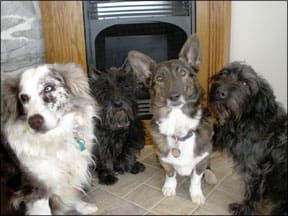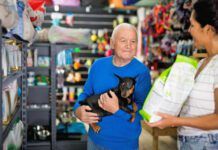You may think feeding your dog is a simple matter of dumping food in his bowl and plopping it down on the floor in front of him. You may be wrong. Mealtime is fraught with significance for your dog, and loaded with opportunities for you to influence his health and his behavior. Failure to take advantage of these could actually contribute to the development and/or escalation of problems that might otherwise be averted. A few deliberate decisions and choices on your part can go far in creating harmony in your home.
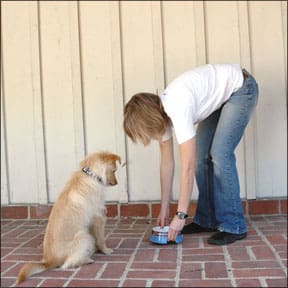
288
What to feed
Many pages in each issue of WDJ are devoted to articles about what to feed your dog, so I won’t go into detail here. Suffice it to say that there is no substitute for a top quality diet for your dog, for both good health and good behavior.
When to feed
When people ask me when I feed my dogs, I tell them I feed twice a day on a regular schedule. My dogs are fed regularly in the morning between 6:30 and 10:00 am, and regularly in the evening between 4:00 and 8:00 pm. Puppies, of course, need to be fed more often, and all my feeding suggestions go out the window if your dog needs a particular diet or feeding schedule due to health reasons.
I am adamantly opposed to “free-feeding,” where food is left down for the dog all the time. You lose a lot of information about your dog’s eating habits and health if you just refill the bowl every time you notice it’s dropped a few inches, and you miss great training and relationship opportunities if your dog has free access to food.
When I feed my dogs, they eagerly lick their bowls clean within minutes. If one of my dogs doesn’t clean her plate, I’m on alert for possible health problems. If she misses two meals, it’s time to talk to the vet. If your dog has food available all the time, you probably wouldn’t notice as quickly, and he might be much sicker by the time you see your veterinarian.
Then there’s the leadership thing. One definition of “leader” in a social group is the one who can control the good stuff. Controlling your dog’s food – when and where he gets it – is just one more way of gently reminding him that you’re in charge. When you put your dog’s bowl down on the floor, full of his tasty dinner, you’re saying, “This is my food, furry friend, and out of the goodness of my generous heart, I’m willing to share it with you.”
While you’re at it, this is an ideal time to implement your “Say please” program, where your dog earns all good things by offering a deference/good manners behavior such as “sit.” If you teach your dog to offer a sit, and wait after you place his bowl on the ground until you release him to eat, you multiply the leadership value of controlling your dog’s access to food.
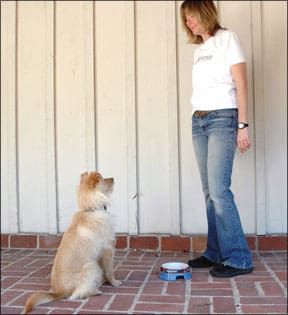
288
Weight control is another good reason for feeding meals instead of having an open food-bar. Lucy’s putting on a few pounds? Time to cut back a few of the California Natural kibbles in her bowl. Scooter’s looking a little thin? Let’s add an extra half-scoop of Merrick’s canned food to his. If you free-feed multiple dogs, you may end up with one on the too prosperous side, while another looks too lean. There could be some subtle resource-guarding going on.
Resource-guarding is yet another reason not to free-feed. It may be subtle, where one dog quietly intimidates another away from the food, or it may be quite blatant, with one dog guarding all the food that’s available from his canine packmates as well as his human family members. Guarding can expand from the bowl and surrounding area to the entire room, and even the doorway and the hall outside.
Your training program is another very important reason to feed meals. Since most positive trainers use food as a reinforcer much of the time, it’s helpful to know when your dog’s stomach is emptier; that’s when he’ll be more reinforced by food. When I have a client who tells me her dog isn’t very food-motivated, I often discover that the dog is being free-fed. You can schedule your training sessions according to your dog’s mealtimes or vice versa. If training class is tonight, hold off on dinner until after class, and then gauge how much dinner he gets based on how many treats he got during class. As long as you use high-quality treats, he won’t be deprived of nutrition by this exchange. If he loves his food, you can even use part of his meal as training treats when you practice his lessons at home during the week.
Some trainers, in fact, recommend hand-feeding all your dog’s meals, at least at first, to take advantage of the relationship-building opportunity of delivering all of your dog’s food directly to him. This has its benefits, especially with undersocialized dogs who need to learn to trust their humans, and those with poor impulse control for whom food delivery can be used as training sessions.
Finally, a dog’s digestive system is designed to eat meals, not graze like a horse. In the wild, canids make a kill, gorge, and go away until it’s time for the next hunt. They don’t need a bowl of kibble, like peanuts on your coffee table, to snack on all day.
Where to feed
Feeding location depends on your dog, and your family’s routine. If your dog guards his bowl, feed him in an out-of-the-way location where you can close the door and let him eat in peace. If you have multiple dogs, feed them in locations that don’t elicit resource-guarding or meal-stealing. We feed three of ours in opposite corners of the kitchen, one in the dining room, and the little Pomeranian in the laundry room with the door closed – both to protect him from intrusion by the big dogs, and because he guards resources. We always stay in the area to referee the big dogs if necessary (it rarely is).
You might choose to feed your dogs in their crates; this keeps everyone contained and minimizes the need for you to referee. It can also exacerbate resource-guarding, so it may not be a good choice for a dog who already aggressively protects his resources. If you have just one dog (or you can separate your dogs), load the food into interactive toys such as Kongs, so he (or they) have to work for their meals.
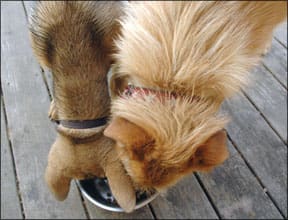
288
Another environmental enrichment feeding plan is to scatter your dog’s food in the yard, so he has to go “hunt” for it. This is not free-feeding; you still just give him one meal’s worth. And it doesn’t work for multiple dogs unless you have separate yards in which to feed them.
How to feed
If you have a single dog, “how to feed” is fairly simple. I already mentioned the value of using “Say please” by having your dog sit and wait while you set his bowl down. You can take that even further, on the days you have a little spare time, by making each meal a training session: set the bowl on the counter and practice several different behaviors before putting the bowl on the floor.
If you live in a multi-dog household, feeding gets more complicated. Who eats first? How do you manage one dog (or more) while you’re putting food down for another?
With five dogs in our family, feeding time is a classical exercise in management. I’m the primary feeder, with Paul doing back-up when I’m not there. I fix all the bowls, placing them on the counter, adding supplements and medications as needed. (Our dogs all get their pills, when they need them, in cheese, on top of their food.) The dogs are gathered around my feet in eager anticipation. When all the bowls are ready, I escort Scooter to the laundry room, popping a cheese-cube in his mouth as we go to forestall his barking. Lucy always wants to follow us; I cue her to “Wait” at the laundry room door, and she gets a bit of cheese when I return – her reward for complying.
Laundry door safely closed, I return to the counter and select Lucy and Missy’s bowls. Lucy (the Corgi) also tends to be vocal, and I feed her next, after a “Sit, wait!” to avoid her editorial comments about the feeding schedule.
Missy (the Aussie) has a tendency to push her way into Lucy’s bowl, so I divert her attention with her bowl in my left hand while I set Lucy’s down on my right. Then a short walk to the dining room to Missy’s spot, by the front door. Missy does three spins as we walk to her rug, then sits and waits until she gets the “Okay!” to eat.
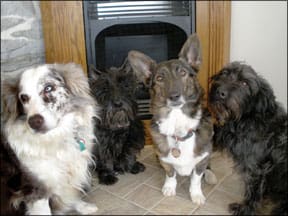
288
Back to the kitchen, where I pick up Bonnie and Dubhy’s bowls. Bonnie (the Scorgidoodle) gets hers by the water bowl on one side of the kitchen (opposite end from Lucy), and Dubhy (the Scottie) gets his in the opposite corner.
By the time Dubhy’s bowl is down, Lucy and Missy have finished and swapped bowls to see if the other has left any crumbs behind. They both respect Bonnie and Dubhy, leaving them alone until they have finished. Then all four play round-robin lick-the-bowl. When the excitement is done I let Scooter out of the laundry room to rejoin the group, and Lucy rushes out to check his bowl.
The order in which I feed is based on my convenience and preference, and has nothing to do with hierarchy. I’m in charge, so I get to decide who eats in what order. Notice that Scooter, who is easily the lowest-ranking member of our canine totem pole, gets to eat first, just because that works best. I want him out of the way of big dog feet before everyone starts dancing around in anticipation of the food’s arrival.
Who feeds?
Lots of families choose the dog’s meal as an opportunity to teach the kids to be responsible. That’s all well and good, providing an adult is supervising to be sure the dog is fed the proper amount, and to be sure the dog actually gets fed. It’s not fair to make the dog go hungry while you try to teach your child a lesson.
In truth, any family member can feed the dog, as long as there’s consistency and reliability. If there’s a family member who genuinely wants to work to improve his relationship with the dog, feeding is a great way to do that. If multiple family members feed at various times, it’s a good idea to have written feeding instructions that detail amount and procedure, so everyone gets it right. And it’s a good idea to have feeding utensils that promote consistent amounts. If your dog gets a half-cup of kibble, keep a half-cup measuring cup in your feed container, so it’s easy to scoop once and get the right amount.
I suggest this technique to keep the dog’s meal size consistent: measure out the correct amount of food, pour it into a paper or plastic cup, and cut the cup with a pair of scissors to the height of the food. Then have the family use that cup as the food scoop.
What to feed in
Last but not least, have you looked at your dog’s bowl lately? Is it clean? Or is it chipped, cracked, scratched, and worn with grungy old food stuck to the edges? Dirty and damaged bowls harbor bacteria that can cause health problems for your dog. I know, they drink out of dirty puddles, eat cat poop, and munch on dead animal carcasses, but still, you can minimize their exposure in your home by keeping their food bowls sanitary.
We’re strongly against using plastic bowls for dog food (and water). Plastic scratches easily – and those scratches trap and hold bacteria. Chemicals in some types of plastic can leach into your dog’s food (or water). Stainless steel is the best choice for dog bowls – and keep them clean!
Maybe you never realized how valuable your dog’s food bowl can be. Now you know. The good news is, it’s never too late to start taking advantage of all the benefits of thoughtful feeding. You can begin today to utilize mealtimes to their full potential. I’d love to see the look on your dog’s face when he realizes he has to sit and wait to get you to give him his bowl!
Pat Miller, CPDT-KA, is WDJ’s Training Editor. Miller lives in Fairplay, Maryland, site of her Peaceable Paws training center.


